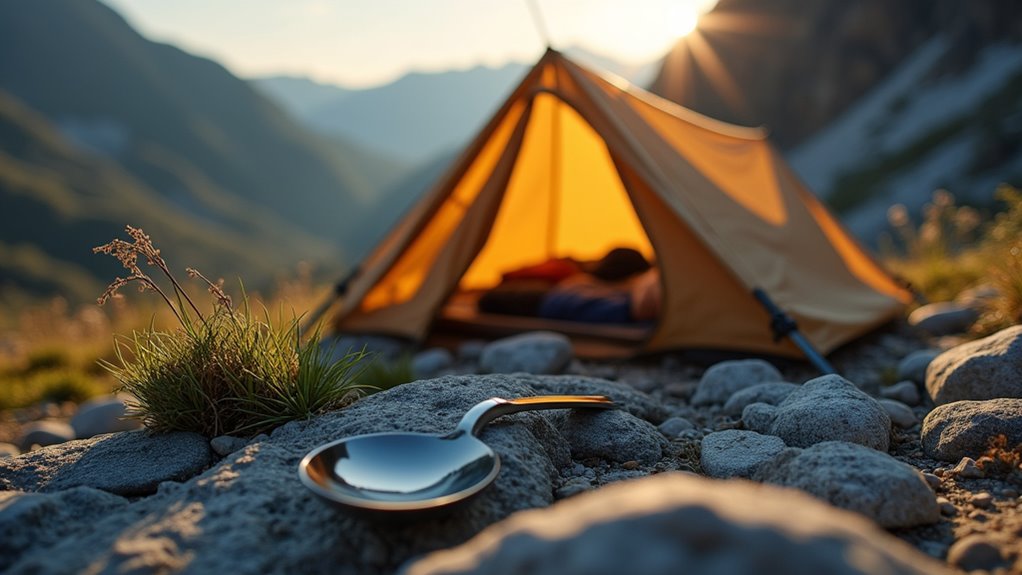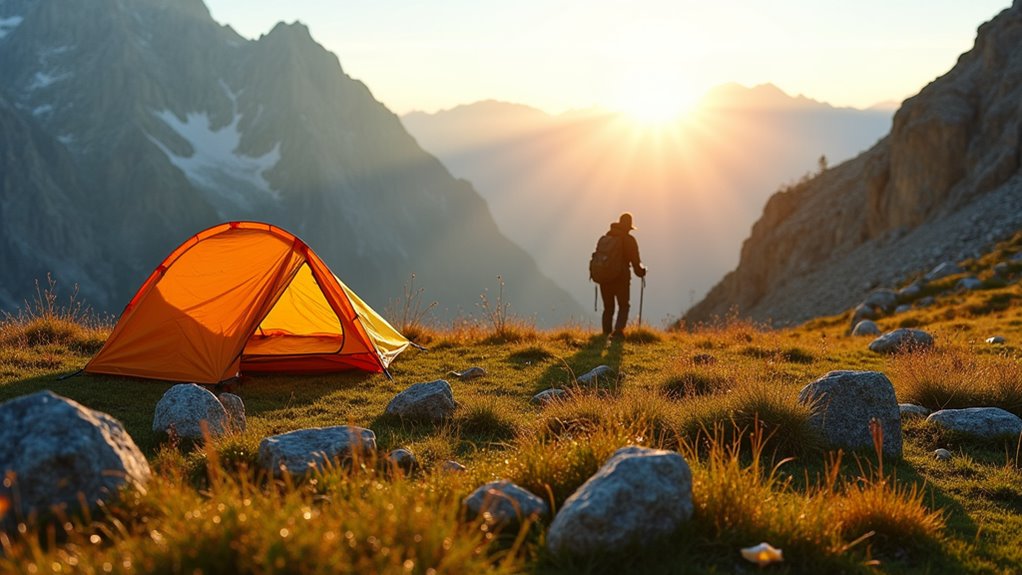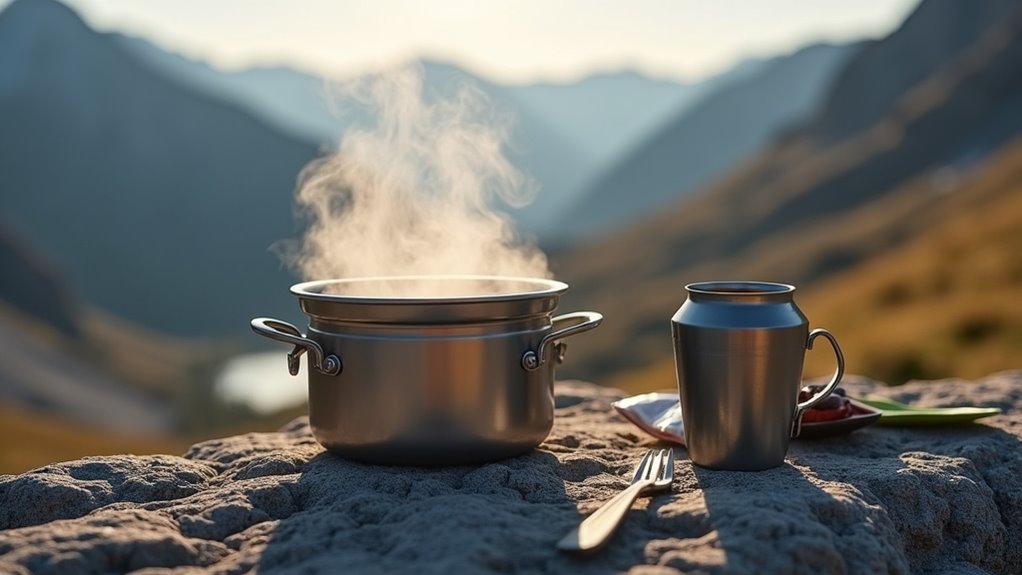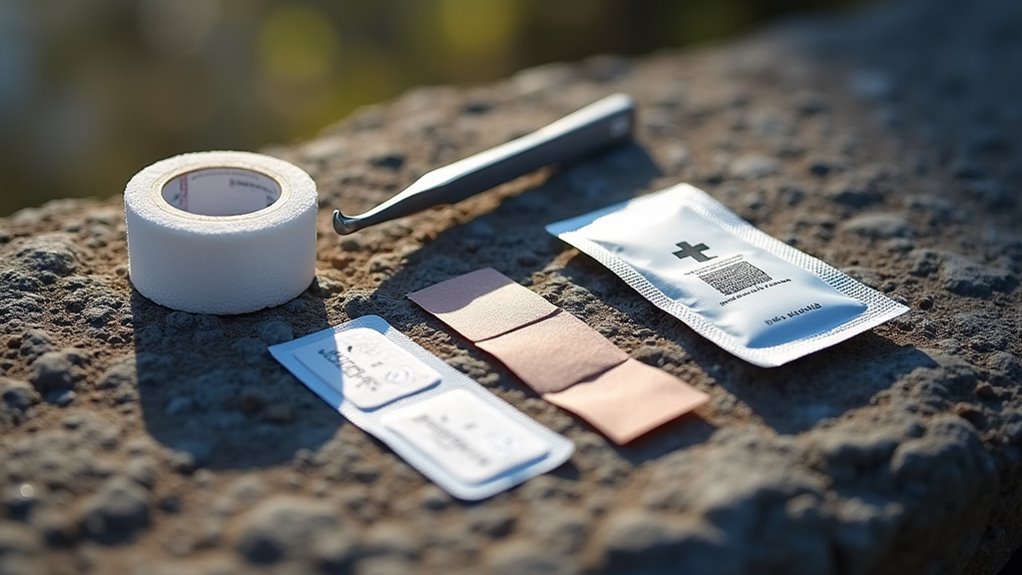Physical Address
304 North Cardinal St.
Dorchester Center, MA 02124
Physical Address
304 North Cardinal St.
Dorchester Center, MA 02124

Keep your pack featherlight with these 9 expert ultralight backpacking strategies that will revolutionize your hiking experience forever.
Like Thoreau seeking simplicity at Walden Pond, you’ll discover that less truly becomes more when you master ultra-light backpacking techniques. Every ounce counts when you’re carrying your world on your shoulders, and smart gear choices can transform a grueling trek into an enjoyable adventure. You don’t need expensive equipment overhauls or extreme sacrifices to cut significant weight from your pack. These nine practical strategies will show you exactly where those hidden ounces are lurking.

When you’re carrying every ounce on your back for miles, each piece of gear needs to earn its place by serving multiple functions. Your hiking poles can double as tent poles, saving significant weight. A bandana works as a towel, first aid bandage, pot holder, or water filter pre-filter.
Choose a smartphone instead of separate GPS, camera, and entertainment devices. Your sleeping pad isn’t just for comfort—it’s also your pack’s frame and chair. Duct tape wrapped around trekking poles eliminates carrying a full roll.
Consider a spork over separate utensils, and pick a jacket that packs into its own pocket for a pillow. Your water bottles can store hot water for warmth on cold nights. Think creatively about each item’s potential uses before it earns pack space.
The multi-purpose approach differs significantly from camping or RVing where weight restrictions aren’t as critical and you can afford to bring specialized single-use items.
While cotton might feel comfortable at home, it becomes your worst enemy on the trail. When wet, cotton stays soggy for hours, sapping your body heat and adding dead weight to your pack. You’ll shiver miserably while your cotton shirt clings to your skin.
Instead, choose synthetic fabrics or merino wool that wick moisture and dry quickly. Look for polyester base layers, nylon hiking pants, and wool socks. These materials weigh less and perform better in all conditions.
Don’t break the bank – discount retailers often carry technical fabrics at reasonable prices. Check thrift stores for brand-name outdoor gear too. Start by replacing your most critical items: underwear, base layers, and socks. You’ll immediately notice the difference in comfort and pack weight.
If you’re planning adventures that involve mobile basecamp setups, consider attending Britain’s Motorhome Show to explore gear storage solutions and compact living strategies that translate well to ultralight backpacking principles.

Your shelter system likely represents the heaviest items in your pack, making it the perfect place to slash significant weight. Consider replacing your traditional tent with a tarp-tent hybrid or ultralight single-wall shelter. These alternatives can cut 2-3 pounds while maintaining weather protection.
Ditch the bulky sleeping bag for a quilt system. Quilts eliminate unnecessary zippers and fabric underneath your body, saving 8-12 ounces without sacrificing warmth. They’re also more affordable than premium sleeping bags.
Swap your thick sleeping pad for a torso-length version. You’ll save weight and still protect crucial areas from ground cold. Use your empty backpack under your legs for extra cushioning.
Finally, leave tent footprints at home. Polycro sheeting weighs mere ounces and provides adequate ground protection at a fraction of the cost.
When selecting any shelter option, focus on choosing a tent that matches your specific backpacking conditions and personal comfort requirements.
Since clothing often accounts for 20-30% of a backpacker’s base weight, mastering the layering system becomes your most effective strategy for dramatic weight reduction. You’ll build an efficient three-layer system: a moisture-wicking base layer, an insulating mid-layer, and a weather-protective outer shell.
Master the three-layer system to dramatically slash your pack weight since clothing represents up to 30% of base weight.
Choose merino wool or synthetic base layers that dry quickly and resist odors, letting you wear them multiple days. Your mid-layer should be a lightweight down jacket or synthetic insulation that packs small. For your shell, select a minimalist rain jacket under 8 ounces.
If you’re planning to stay at established campgrounds during your backpacking journey, consider how self-contained camping trailers offer convenient amenities that could allow you to pack even lighter by eliminating certain comfort items from your load.

Because cooking gear typically represents 15-20% of your pack weight, swapping out heavy traditional equipment for ultralight alternatives will slash pounds from your load. Replace your hefty camp stove with a lightweight canister or alcohol stove that weighs under 3 ounces.
Ditch the bulky pot set for a single titanium cup that doubles as cookware. You’ll save serious weight and money.
Skip the full spice rack—bring salt, pepper, and one multi-purpose seasoning in tiny containers.
Cold-soak meals like couscous, instant mashed potatoes, and oatmeal eliminate stove weight entirely.
Pack a lightweight spork instead of full utensil sets.
Consider dehydrated meals over canned goods—they’re lighter and pack smaller while providing the same nutrition. Remember that proper food storage is essential for ultralight backpacking to prevent spoilage and maintain food safety throughout your trip.
After optimizing your cooking gear, turn your attention to your sleep system—another major weight contributor that’s ripe for trimming. Your shelter, sleeping bag, and pad choices can dramatically impact your pack weight without sacrificing comfort.
Start by evaluating your sleeping bag’s temperature rating—you’re likely carrying more insulation than needed. Switch to a quilt instead of a traditional mummy bag to save 4-8 ounces while maintaining warmth.
Most backpackers overpack insulation—quilts deliver identical warmth as mummy bags while shaving up to half a pound from your load.
For your pad, consider switching to a shorter torso-length version that covers shoulders to hips.
Understanding the different sleeping bag types available will help you make more informed decisions about weight-saving alternatives for your specific camping conditions.

While many hikers pack extensive first aid kits “just in case,” you can streamline yours to essential items that’ll actually get used on the trail. Focus on treating common injuries: blisters, cuts, and minor pain. Pack blister treatment like moleskin or tape, antiseptic wipes, and a few adhesive bandages.
Include ibuprofen for pain and inflammation, plus any personal medications.
Skip bulky items you can’t properly use without training. Instead of multiple bandage sizes, bring versatile medical tape and gauze. Repurpose gear—duct tape works for blister prevention and gear repairs.
Consider lightweight alternatives like liquid bandage instead of traditional bandages.
Your streamlined kit should weigh under four ounces while covering realistic trail scenarios, not every possible emergency. Remember that having a first-aid kit is essential for ensuring your safety during any camping adventure.
Though it’s tempting to pack backup gear for peace of mind, you’ll slash significant weight by trusting your primary equipment and ditching redundancies. Instead of carrying two water bottles, stick with one plus a lightweight backup like a collapsible container. Skip the spare headlamp if your phone has a reliable flashlight. Ditch duplicate items like multiple knives, extra batteries beyond what’s necessary, or backup cooking systems.
Focus on multi-use gear that eliminates redundancy entirely. Your trekking poles can double as tent poles. Dental floss works as emergency thread. This mindset shift requires confidence in your primary gear, so invest in quality pieces you trust completely.
Smart backpackers choose gear that serves multiple purposes, reducing pack weight while maintaining functionality through clever dual-use items.
Remember that summer camping brings unique challenges like extreme heat and sun exposure, so prioritize lightweight protection over redundant equipment when making gear decisions.

Beyond eliminating redundant gear, you can shave ounces by ditching manufacturers’ bulky packaging and transferring items into smaller, lighter containers. Those heavy shampoo bottles and oversized first-aid kits add unnecessary weight.
Transfer toiletries into tiny travel bottles or contact lens cases. Repackage medications in lightweight pill containers, keeping only what you’ll need. Use small ziplock bags for spices, soap powder, and vitamins instead of original packaging.
Replace bulky gear cases with lightweight stuff sacks or compression bags. Even swapping out heavy carabiners for lightweight versions saves weight. Don’t forget about duct tape – wrap a few feet around your trekking poles instead of carrying the entire roll.
When organizing your repackaged items, consider the layout of your hiking bag to ensure easy access to frequently used supplies while maintaining optimal weight distribution.
These simple swaps won’t cost much but will considerably reduce your pack weight.
You’ll transform your backpacking experience like a sculptor chiseling away excess stone—every ounce you eliminate reveals a more enjoyable adventure beneath. Don’t overthink it; start with what you’ve got and gradually replace gear as your budget allows. Focus on the biggest weight savers first: shelter, sleep system, and pack. You’ll be amazed how these simple swaps turn grueling slogs into pleasant hikes, letting you cover more ground with less effort and greater comfort.